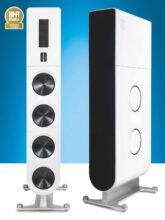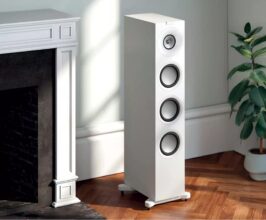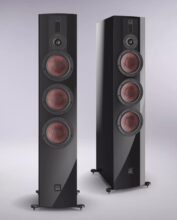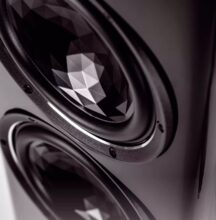FALCON ACOUSTICS RAM STUDIO 30 Review – Falcon flies again
Falcon Acoustics has been part of UK hi-fi’s fabric for decades, but now it’s the new kid on the block too. David Vivian explains all. Read our FALCON ACOUSTICS RAM STUDIO 30 Review.
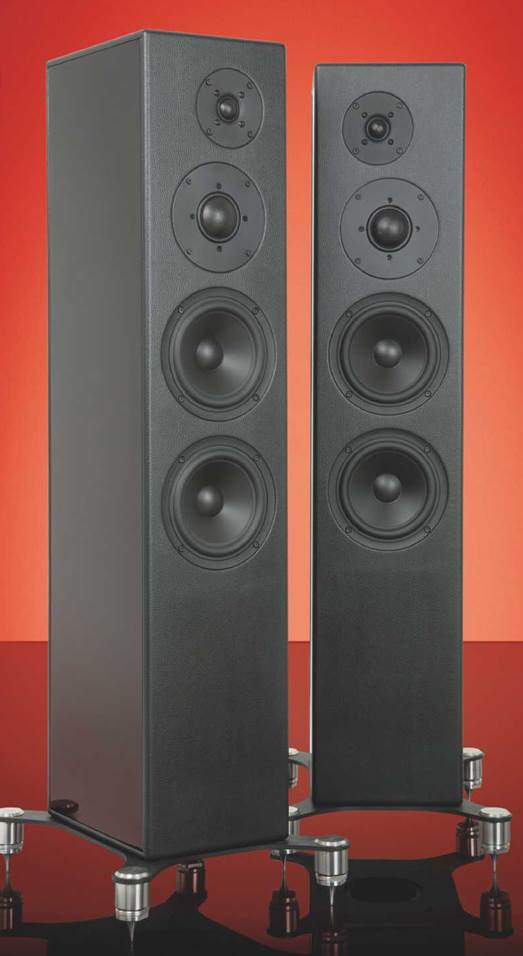
DETAILS
Falcon Acoustics RAM Studio 30
ORIGIN UK/Italy
TYPE 3-way floorstanding loudspeaker
WEIGHT 35kg
DIMENSIONS (WxHxD) 215 x 1,100 x 300mm
FEATURES
• 1 x 25mm soft dome tweeter
• 1 x 50mm soft dome midrange driver
• 2 x 170mm Polypropylene bass drivers
• Quoted sensitivity: 89dB/1W/1m (8 ohm)
DISTRIBUTOR Karma-AV
TELEPHONE 01423 358846
WEBSITE karma-av.co.uk
Before we get to the brand new and rather imposing tower you see before you, a little Brit-fi archaeology. You’ve doubtless heard of Falcon Acoustics, not least for its assertion that among the host of latter-day copies, it makes the most authentic and accurate recreation of the legendary BBC LS3/5a standmount monitor. A decent enough claim to fame. But to fully appreciate the provenance of the company, its specialisations and its aspirations, we must dig deeper.
It reveals harmonics, dynamic contrasts and proportion that align with reality
It all started with Malcolm Jones who, in 1961, enjoyed the unique distinction of being the first person to be employed by Kent-based speaker maker KEF Electronics Ltd. Jones was given the title of senior development engineer and that’s precisely what he did, going on to develop and engineer KEF’s most lauded drive units – the B139, B200, B110, T15, T27 – as well as their implementation in KEF’s numerous speaker systems.
He left KEF in 1974, his final act being to sign off the acclaimed Reference Series 104. By then, a nascent Falcon Acoustics – started on the kitchen table of the Jones family home in Bexhill, Sussex, by Malcolm and his wife Valerie – was two years old and crying out for its founders’ full-time attention as well as more appropriate premises, found subsequently in Mulbarton, Norfolk. Now offering a range of drivers designed by Malcolm Jones plus related components to supply the burgeoning DIY speaker kit market (notably ferrite-cored inductors in
their hundreds of thousands over the years), operations moved again in 2003 to Acle, a small town on the A47 midway between Norwich and Great Yarmouth.
Expansion included acquisition of Nightingale Acoustics in 1978 and a thorough revamp of its range, while the early eighties saw Falcon take on distribution for Focal – fittingly, as Focal used Falcon’s ferrite inductors in its kits and JMlab speaker systems. But the DIY retail/mail-order side of the business continued to blossom and today Falcon is the largest supplier of drive units in the UK. It’s also the badge on an entirely new family of RAM (Reference Audio Monitor) Studio series speakers being marketed and distributed by Karma-AV and lining up alongside stablemates JBL and Primare among others.
Millennium falcon
Malcolm Jones retired in 2009, selling Falcon Acoustics to Jerry Bloomfield in Oxford but continuing his association with the company he founded as a technical consultant. Karma-AV entered the frame just before this year’s Bristol Sound & Vision Show. And if you’re thinking RAM rings a bell and wondering why it figures in all of this, it’s because Falcon worked closely with RAM Electronics Ltd. (1974-1983) and supplied the long defunct speaker maker with crossovers during its nine years in business. What goes around and all that…
There’s more in the way of distinctly up-market fare from Falcon in the pipeline. The forthcoming Reference series, which will be sold in both passive and active forms, promising graphene composite cone bass drivers no less and “stunning cabinet design”. For now, though, the passive-only RAM Studio 30 is as good as it gets.
The range kicks off with the Studio 10. A two-way
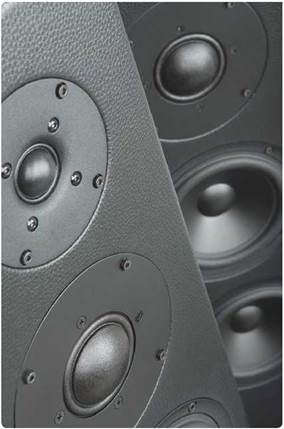
The baffle’s use of ‘man-made’ leather is purely for aesthetic purposes ported standmount with a 150mm polypropylene cone mid/bass driver and 25mm soft dome tweeter, Falcon says it’s designed to deliver a smooth and detailed response, precise imaging and an extended soundstage. Rated at 89dB sensitivity into 8 ohm, it should be an easy enough load for most modern integrated amps.
The larger Studio 20 is also a two-way ported design, but with a 170mm polypropylene cone mid/bass driver and the same, but this time offset, 25mm tweeter. The Studio 20 aims to provide greater bass extension and weight than the Studio 10, a wide soundstage and – with its offset tweeter – “exceptional imaging”. At 88dB into 8 ohm, it’s a little less sensitive than its smaller sibling, but again shouldn’t require the services of a hulking amp to be able to perform well.
That said, neither standmount really gets close to the sheer size, bulk and sonic ambition of the floorstanding Studio 30, which although gracefully slim, stands over 1,100mm tall on its spiked metal plinth with screw fixings, and raises the cabinet’s large downward-firing port from the ground. At 35 kg each, the 30 is the kind of weight that demands bionic knee joints just to move it a few metres and would take a rugby tackle just to unbalance it.
IN SIGHT
1 25mm soft dome tweeter
2 Binding posts
3 Adjustable spikes
5 50mm soft dome midrange driver
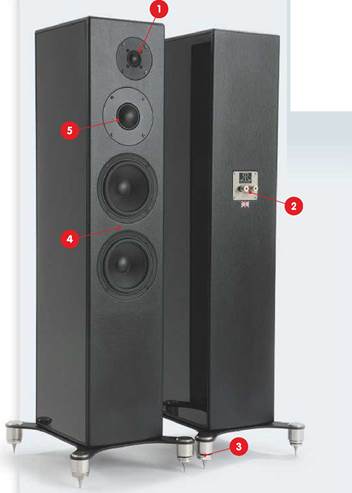
4 2x 170mm Polypropylene bass drivers
The custom-designed 25mm soft dome tweeter is offset, meaning it can be either inside or outside the centre axis depending on which way round the speakers are sited. Convention dictates inside, but much hinges on the room’s size and shape and it never hurts to experiment.
No prizes for guessing that the Studio 30 is a three-way design, but award yourself a bonus point for spotting the proprietary 50mm dome midrange unit, a driver type more usually associated with fellow Brit loudspeaker brands ATC and PMC. It shares the baffle with two 170mm polypropylene cone bass drivers.
Of all the Studio models, the 30, unsurprisingly, is claimed to have the widest bandwidth, the clearest midrange and the most even tonal balance top to bottom. And if that large downward-firing port suggests anything, it’s powerful deep bass. So although the claimed 89dB sensitivity rating promises ample loudness for a modest investment of watts, an amp with more than a modicum of low-end grip would be a good move.
Sound quality
Auditioning commences with my resident Yamaha CD-N301 network CD player (HFC 401) – acting chiefly as a CD transport – and Emotiva BasX PT-100 preamp’s on-board AD1955 24/192 chip from Analog Devices taking care of digital conversion while the matching A-300 power amp (both reviewed HFC 429) drives the speakers via lengths of Townshend Isolda DCT loudspeaker cable.
Hi-fi is all about illusion and even with large and expensive multi-driver exemplars of the floorstanding art, it’s hard to shake the feeling that you’re listening to a reconstruction, however exquisitely sewn together. But the Studio 30 gets closer than most. Give it something with a raw, ‘live’ patina and it’s almost scarily convincing. I’m still playing Boz Scaggs’ hugely enjoyable Out Of The Blues and the Falcon could almost have been built for the task. Except that nothing about the Studio 30’s presentation sounds like a task. What’s so striking is the absence of effort, the sense of absolute solidity and authority, a weight and potency redolent of a living, breathing, dynamic musical event. Boz and the boys might as well be sat playing in the room with me.
But that’s relatively simple stuff.
A step-up in scale and complexity requires a little more from the talent well. For example, a well-recorded orchestra’s string section should have some harmonic roughage amid the silky wash and brass instrumental tonal depth that goes beyond bright, raspy and metallic. Take almost any Michael Buble production and whatever you think of the Canadian’s caramel crooning, the orchestral backing is always immaculately recorded, sometimes just a tad ‘hot’, which can tip some speakers into aggression. The Studio 30, however, totally nails it, revealing a whole
The midrange’s transparency and sheer naturalness is quite sublime
world of harmonics and dynamic contrasts, but just as importantly a sense of proportion that aligns more closely with reality. The Falcon has no need to exaggerate or manipulate. Yes, it has great bass – and not just the kind that makes Marcus Miller’s Fender Jazz Bass guitar on its latest album outing, Laid Black, sound palpably fatter and gutsier. Here’s a speaker that marries oodles of low frequency energy with definition and discipline and it’s a combination that doesn’t just bring low notes to life, but also the acoustic and ambient glow of the venue they’re played in.
So let’s draw a line here. This isn’t the kind of speaker that tries to ambush your attention with the ear-popping pizazz some similarly priced systems trade in. Instead, you might notice the sheer range of subtle tonal colours on offer with the stripped-down arrangements that take precedence on the new Paul Weller album, True Meanings. On the other hand, the Studio 30 can run with the most outrageous dynamic
With the price of the most luxuriously finished Studio 30 topping out at just over £4k, the biggest threat comes from Q Acoustics’ outstanding Concept 500, which doesn’t just look a little sexier and more modern than the Falcon (check out their respective metal plinths), but has knocked both critics and customers sideways with the remarkable quality of its sonics. In that respect, at least, the Studio 30 can hold its own – thanks in part to its soft dome midrange driver, which gifts it clarity and insight in the presence region that just shades the best efforts of the superb QA.
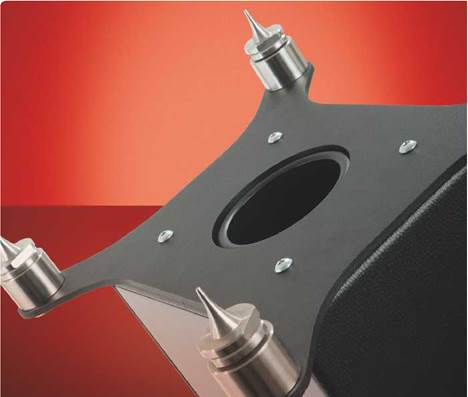
swings, but does so in a perfectly calm and controlled fashion so that there’s never any hint of hype. This is the calibre of stuff that, in the long run, draws you in and keeps you hooked. In short, the Studio 30 doesn’t overplay its hand. It has poise and control that’s never found wanting.
This puts this loudspeaker in true high-end territory. It handles the frequency extremes beautifully, but the transparency and sheer naturalness of its midrange is sublime, eschewing the tickled-up presence favoured by some for believable balance and detail that serves the music rather than detracting from it.
Conclusion
With roots that reach back to the early days of KEF and a portfolio that contains what many regard as the finest modern-day reproduction of the classic LS3/5a, it’s probably fair to say that Falcon Acoustics invites preconceptions of a speaker maker stuck in the past. Nothing could be further from the truth. The RAM Studio 30 is a potent, wide-bandwidth speaker system that balances its dynamic reach and ability to go loud with grace, warmth, terrific resolving power and a feeling of spatial coherence that ranks with the very best. No need to rest on its laurels now, Falcon is back
OUR VERDICT
FAMILY AFFAIR
Falcon’s Jerry Bloomfield says that the avoidance of a fashionably forward, in-your-face presentation informs the RAM Studio signature sound. Cabinets are constructed in Italy from 25mm MDF and finished in European walnut, high gloss black or burr walnut real wood veneers, complemented by a man-made leather dressing for all surfaces bar the side panels and base. Bloomfield looked to Italy for its time-honoured expertise in these areas and the opportunities it afforded, leading to interchangeable side panels that make it easier to match speakers with decor. Also shared across the range are Falcon’s heavy-duty binding posts mounted on 2mm stainless steel plates. For the Studio 30, a substantial metal plinth is provided complete with chunky CNC precision-engineered stainless-steel spikes. The structure doesn’t just expand the speaker’s footprint to aid stability but also raises its downward-firing bass reflex port from the floor, giving just enough space to breathe properly while increasing the range of placement possibilities as the port is less susceptible to boundary reinforcement.
Q&A
Jerry Bloomfield
Managing director, Falcon Acoustics
DV: The RAM Studio 30’s baffle is dressed in what you call man-made leather. What is it and does it confer any sonic benefits?
JB: It’s a purely decorative finish and was selected for its looks and durability. The cabinets are made in Italy, which has a long tradition of cabinet craftsmanship where it is easier to get the level of skill that’s needed for this type of work.
Did you ever consider making the Studio 30 a sealed box design?
No, it was designed from the outset as a ported speaker, as we wanted to maximise available bass extension from the custom bass drivers in this size of cabinet. Sealed box speakers can limit bass capability unless you go for large cabinets and big drive units, so by porting the cabinet we are achieving a good level of bass energy from a box that integrates well with a range of rooms. We chose a down-firing port as this makes positioning easier, and we designed the plinth and CNC spikes to maintain the correct floor-to-port height for the majority of floor finishes.
Studio monitors can sometimes sound a little dry and analytical. Is the Studio 30 voiced for broader domestic acceptance?
Agreed, some speakers can sound a bit dry and acutely analytical, and not just studio monitors. I’ve listened to many speakers over the years, and to my ears the current trend is to accentuate response at the poles at the expense of midrange information. We get similar comments to yours from visitors at audio shows who arrive at our room having listened to the ‘latest thing’ down the corridor. Because we’ve been auditioning, testing, manufacturing drivers and systems for many decades, Falcon has adopted a more traditional approach to voicing, so for the Studio 30 we spent a lot of time integrating and refining the 50mm midrange dome to achieve a far more even and balanced response. We wanted it to be musical, informative, but above all enjoyable to listen to.



